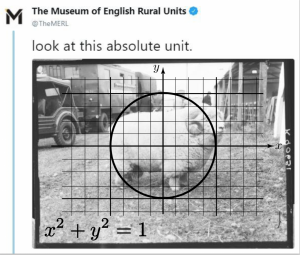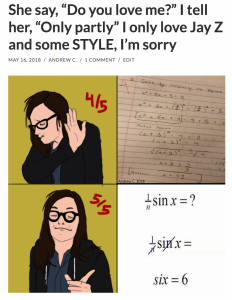Excellent memes, everyone! Congratulations to Andrew, whose amazing meme below was the overwhelming favorite, with 2/3 of the vote.
Author: Kate Poirier (Page 1 of 4)
Sorry everyone…as I warned in class today, my cold has got the better of me and I have to cancel the 3-5pm office hours today so I can head home. If you’d planned to stop by, send me an email with a specific question and I’ll do my best to answer it. I should be able to answer emails until about 4:30 tomorrow.
Good luck with your last-minute exam prep!
There are a few small loose threads to tie up next Tuesday, and you might have questions about yesterday’s lecture. Other than that, I won’t plan anything in particular for next Tuesday. Prepare for the exam as though it’s on Tuesday, and come to class ready to ask specific questions so you can focus your last-minute prep.
Since the last example from yesterday’s class was a little rushed, I thought I’d post it here.
In our zombie example, we assumed two things:
- One zombie arrives in New York on day 0,
- Each zombie infects one person and turns them into a zombie each day.
We saw that the number of zombies on day n is $2^n$. If there are 8 million people in New York, then to find out how long it takes for everyone in the city to become a zombie, we have to solve the equation:
$2^n=8,000,000$.
Before we solve this equation, I want to point out that it’s similar to one we solved to evaluate a logarithm without without the calculator:
$9^x=3\sqrt{3}$
In this case, we wrote both sides of the equation as powers of 3, and then we equated the exponents to solve for $x$. We could imagine doing something similar to solve the zombie equation—8,000,000 *is* a power of 2—but it’s not an obvious power of 2, so we’ll use logarithms to find $n$.
There are a few methods that are all roughly the same. Here’s the one we discussed in class today.
Method 1
Take the logarithm with base 2 of both sides:
$\log_2(2^n)=\log_2(8,000,000)$.
Use logarithm rule (3); the exponent becomes a coefficient:
$n \log_2(2) = \log_2(8,000,000)$.
Since $\log_2(2)=1$, we have:
$n = \log_2(8,000,000)$.
Some calculators will let you choose your base for your logarithm but most will not. If your calculator will not let you choose base 2, you will have to use the change of base formula:
$log_b(x)= \frac{\log_c(x)}{\log_c(b)}$.
Scientific calculators have a button “log” (remember this means base 10). This is called the “common logarithm.” They also have a button “ln” (remember this means base e which is about 2.718). This is called the “natural logarithm.” It’s up to you whether you want to use the common logarithm or the natural logarithm. If we choose the common logarithm (c=10) for the change of base formula, we get:
$n = \log_2(8,000,000) = \frac{\log(8,000,000}{\log(2)}$.
Plugging this in on the calculator, we see that $n \approx 22.93$. This is close to the answer we got in class, which used that $2^23 = 8,388,608$.
Method 2
Method 2 is almost identical to Method 1 but instead of taking log with base 2 of both sides, we take either the common log (base 10) or ln (base e) to begin with. This means we won’t have to use the change of base formula. I’ll choose base 10 again:
$\log(2^n)=\log(8,000,000)$.
Again, using log rule (3), we get:
$n\log(2)=\log(8,000,000)$.
Now, divide both sides by $\log(2)$:
$n=\frac{\log(8,000,000)}{\log(2)}$.
Notice this is exactly what we got using Method 1 in our last step before pulling out the calculator, so the two answers are equal.
Our second example asked us how long it’d take to have \$15,000 in an account if we deposit \$100 and it earns 24% interest, compounded monthly. This means we have to solve the equation:
$ 15,000=100(1+ \frac{0.24}{12})^{12t}$
Again, the variable is in the exponent, so we need logarithms to isolate it. Try using Method 1 or Method 2 to solve this equation.
Test #3 Review – due May 15
Test #3 Review OpenLab posts are due tomorrow, Tuesday, May 15 at 10am. Don’t forget to add the category Test #3 Review to your post.
Test #3 Solutions – due May 22
Test #3 will be returned in class tomorrow. The Test #3 Solution OpenLab exercise is identical to the ones you completed after Tests #1 and #2 except now you will each chose a Test #3 question. Do not post a photo of the solution from your actual final exam; choose a question you did not get full credit on (or one you didn’t answer) and share your carefully written solution. Your OpenLab posts are due by Tuesday, May 22 at 10am. Don’t forget to add the category Test #3 Solutions to your post.
Edit: For those of you who were absent on Tuesday, here’s a copy of the test questions: Test #3.
Final Exam Review – due May 24
Your final exam review exercise is similar to your previous Test Review exercises. This time, you will choose a question from the updated Final Exam Review sheet, write a complete solution, and post it on the OpenLab with the category Final Exam Review. There are almost 50 individual questions; make sure you post a solution that hasn’t been posted already. Your OpenLab posts are due by Thursday, May 24 at 10am.
Participation Grades – by May 24
Each of the above exercises is worth one point toward your participation grade. Ten participation points total are required for full participation credit. Your current participation points will be posted in Blackboard shortly. If your current participation grade is lower than 10, you can increase it by
- submitting OpenLab posts for the above assignments
- sharing your work on the board during class
- asking/answering questions on the OpenLab x Webwork Ask for Help page
- attending office hours
- attending tutoring (ask the tutor for a verification slip to give to me…there are different tutoring programs around campus; I encourage you to visit the Atrium Learning Center tutors in AG-25)
Edit May 15: Your participation grade as of 9pm May 15 (not including extra credit) is now posted on Blackboard. This grade is a sum of 6 numbers:
- The number of times you’ve participated in an OpenLab assignment
- The number of times you shared your work on the board during class
- The number of times you’ve attended office hours
- Your effort score on the spring break activity
- Your effort score on the spring break quiz
- The number of verification slips from tutoring that you’ve given to me
If you have any questions about these grades, we can talk in office hours next Tuesday.
Webwork – due May 23
Don’t forget, all old Webwork sets have been reopened. Everything is now due next Wednesday, May 23 (the night before the final exam). Keep in mind, some sets are due at the usual time, 11:59pm, and others are due earlier, at 11:58pm.
Extra Office Hours – May 22
Next Tuesday, May 22, I will be in my office as usual from 12-1pm and I will also be there 3-5pm. Prepare as though you were taking the exam on Tuesday. Then, you’ll be ready to ask questions efficiently on Tuesday and still have time for a little more last-minute practice before Thursday.
Extra-Credit Assignment – due May 22 and 24
Details of the assignment are here. Memes are due by Tuesday, May 22 at 10am; votes are due by Thursday, May 24 at 10am.
Final Exam – May 24
Your final exam will be given during usual class time 10am-11:40am on Thursday, May 24. Remember your calculator. Plan to arrive early, in case the subway interferes with your commute.
Here is my own attempt at making a math meme…

You can now upvote and downvote OpenLab posts (click on the thumbs-up or thumbs-down icon). This will NOT count as your official vote for the best meme, but you can upvote to tell the meme-maker that you like what they created. Wait until after next Tuesday, when all the memes have been submitted, to decide which meme you’ll officially vote for; you can vote officially only once.
This assignment is inspired by Julia’s amazing distracted boyfriend/freshman’s dream meme find. Your assignment is to make your own math meme. The rules are:
- it has to involve real math (it doesn’t have to be math from this course)
- it has to be family friendly (nothing too racy)
- it has to be your original content (not copied from somewhere)
- you may submit as many different memes as you like.
You might like to use an online meme generator like the one here. Do your best to make your meme relevant and funny, like Julia’s. This might be hard; I’ll include one of my own but it won’t be very funny.
Part 1
Submit your meme as an OpenLab post by Tuesday, May 22 at 10am with the category Extra Credit. Everyone who submits at least one meme will earn one point toward their participation grade.
Part 2
After everyone’s memes have been posted, you will vote for the best one. You will vote by commenting on that OpenLab post with just the word “vote.” Votes are due by Thursday, May 24 at 10am. The person with the most votes will earn an extra 2 points, added to their overall grade (in addition to the participation point).
Survey
At the beginning of the semester, I announced that our section of MAT 1275 is an Opening Gateways section and that, for the most part, this would only be a behind-the-scenes difference. As a student in an Opening Gateways section, however, you are required to complete a short survey. You can read the consent details at the top of the form. Please answer honestly; I will not see your responses.
Link to survey: https://cunysud.formstack.com/forms/title_v_student_survey
(I may be able to obtain the list of names from the survey administrator; if I can, completing the survey will be good for one participation point.)
Webwork
All old Webwork sets have been reopened and are now due Wednesday, May 23 (the night before your final exam). You may continue working on them to improve your grade. Pay careful attention to the times that the sets are due:
- There are 6 sets on exponential and logarithmic functions (those whose original deadlines had not passed). These are due at 11:58pm:
- ExponentialFunctions
- LogarithmicFunctions
- LogarithmicProperties
- CompoundInterest
- ExponentialEquations
- ExponentialEquations-Calc
- All remaining sets (those whose original deadlines had passed) are due at 11:59pm as usual.
Test #3 will be held in class this Thursday, May 10. Check the schedule for the topics covered. The test will cover sessions 18-25 (all of trigonometry).
Like for Tests #1 and #2, choose one question from Webwork, textbook homework, or the final exam review sheet to complete and share on the OpenLab. Don’t forget to add the category Test #3 Review before you publish your post. Let us know in the post title where the question is coming from. Posts are due by 10am on Tuesday, May 15 (despite being after the test; posting before the test is better).
Do your best to choose problems that you think others might struggle with.
This assignment will count toward your participation grade.
Test #3 will be given in class next Thursday, May 10. It will cover sessions 18-25 of the schedule (all of trigonometry).
Webwork TrigEquations has some questions about principal roots where it will accept one answer only. This differs a little from what we called principal roots in class. You can look at section 6.2 for a detailed explanation about what makes a root principal (the ranges for the angles depend on which inverse trig function you’re using). Don’t worry too much about the exact definition of principal root for now; I won’t ask you for them using this language on next week’s test. For Webwork, you can use your calculator’s inverse trigonometric function button and for the most part, it will give you the principal root that you can enter. Webwork still might not accept your calculator’s answer for #5, but there will be only one other candidate root in $[0,2 \pi)$ and Webwork will accept that one.
Here is the Law of Sines animation from today’s class. You can play with it to see that the SSA case might be ambiguous when you’re using the Law of Sines to find an angle.






Recent Comments